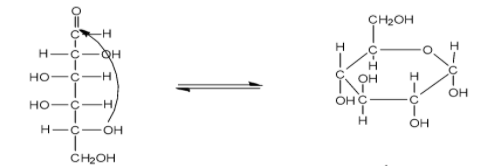
Answer
432k+ views
Hint: The answer here is based on the fact that pyranose ring structure has five carbon atoms and the hemiacetal linkage will be between that carbon atom which forms a five membered ring structure and this gives the required answer.
Complete answer:
We have studied in the chemistry classes about the structure of glucose and also have known about its two forms that is D – glucose and L – glucose.
Now let us see how it forms a pyranose ring structure and hemiacetal formation.
- Glucose is a carbohydrate and is a monosaccharide sugar that is shown by the linear structure or also by the cyclic structure.
- Since pyranose is a cyclic form having five carbon atoms and one oxygen atom that overall forms six membered structures.
- The linear chain of glucose is converted to pyranose form by the process called mutarotation.
- The hemiacetal linkage is the combination of two functional groups with the alcohol part and the ether part attached to the same carbon atom.
Thus, this mutarotation form is as shown in the diagram below,

In the above figure, we can see the conversion of linear structure of glucose into pyranose ring and this is from the carbon at ${{C}_{1}}$ and ${{C}_{5}}$
Therefore, the correct answer is option A).
Note: Note that mutarotation is nothing but the process in which there occurs a change in the optical rotation because of the change in the equilibrium between two anomers when the corresponding stereo centres interconvert. Cyclic sugars usually show mutarotation when alpha and beta anomeric forms that interconvert
Complete answer:
We have studied in the chemistry classes about the structure of glucose and also have known about its two forms that is D – glucose and L – glucose.
Now let us see how it forms a pyranose ring structure and hemiacetal formation.
- Glucose is a carbohydrate and is a monosaccharide sugar that is shown by the linear structure or also by the cyclic structure.
- Since pyranose is a cyclic form having five carbon atoms and one oxygen atom that overall forms six membered structures.
- The linear chain of glucose is converted to pyranose form by the process called mutarotation.
- The hemiacetal linkage is the combination of two functional groups with the alcohol part and the ether part attached to the same carbon atom.
Thus, this mutarotation form is as shown in the diagram below,

In the above figure, we can see the conversion of linear structure of glucose into pyranose ring and this is from the carbon at ${{C}_{1}}$ and ${{C}_{5}}$
Therefore, the correct answer is option A).
Note: Note that mutarotation is nothing but the process in which there occurs a change in the optical rotation because of the change in the equilibrium between two anomers when the corresponding stereo centres interconvert. Cyclic sugars usually show mutarotation when alpha and beta anomeric forms that interconvert
Recently Updated Pages
what is the correct chronological order of the following class 10 social science CBSE

Which of the following was not the actual cause for class 10 social science CBSE

Which of the following statements is not correct A class 10 social science CBSE

Which of the following leaders was not present in the class 10 social science CBSE

Garampani Sanctuary is located at A Diphu Assam B Gangtok class 10 social science CBSE

Which one of the following places is not covered by class 10 social science CBSE

Trending doubts
How do you graph the function fx 4x class 9 maths CBSE

Which are the Top 10 Largest Countries of the World?

The Equation xxx + 2 is Satisfied when x is Equal to Class 10 Maths

Difference Between Plant Cell and Animal Cell

Difference between Prokaryotic cell and Eukaryotic class 11 biology CBSE

1 ton equals to A 100 kg B 1000 kg C 10 kg D 10000 class 11 physics CBSE

In Indian rupees 1 trillion is equal to how many c class 8 maths CBSE

The largest tea producing country in the world is A class 10 social science CBSE

One Metric ton is equal to kg A 10000 B 1000 C 100 class 11 physics CBSE



